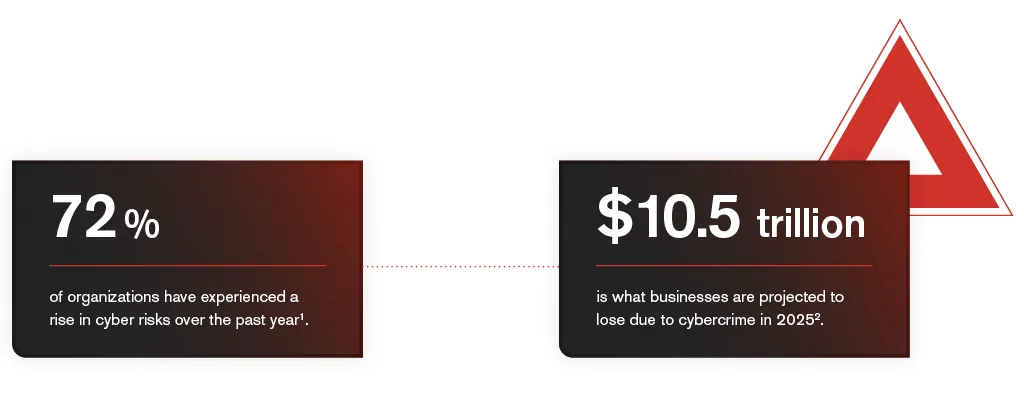The stakes for cybersecurity have never been higher and Managed Security Service Providers (MSSPs) sit at the frontline. Their role has evolved beyond simply managing firewalls and monitoring endpoints. Today, MSSPs must act as strategic defenders, capable of predicting, identifying, and neutralizing advanced threats before they disrupt business operations. The traditional, perimeter-based security model is no longer sufficient. The enemy has become smarter, more persistent, and increasingly well-funded, exploiting blind spots in systems that weren’t designed for the modern threat landscape.
AI-driven attack vectors, geopolitical disinformation campaigns, and weaponized deepfakes are reshaping how attacks unfold. Simultaneously, the explosion in cloud infrastructure, remote workforces, and connected devices has vastly expanded the attack surface. According to the World Economic Forum, 72% of organizations have experienced a rise in cyber risks over the past year1. Economically, cybercrime is projected to cost businesses up to $10.5 trillion by 2025, potentially escalating to $15.63 trillion by 20292. MSSPs must adapt or risk becoming the weakest link in their clients’ security chain.
This is why the shift from reactive to proactive, intelligence-driven defense is no longer optional. For MSSPs, it is a strategic necessity. Reactive defense mechanisms, like basic intrusion detection systems or after-the-fact alerts, leave clients vulnerable to advanced persistent threats (APTs) and zero-day exploits that bypass conventional defenses. In contrast, deception-powered threat intelligence allows MSSPs to stay ahead of adversaries and transform threat detection from a passive to a predictive process.
As we move into a year marked by escalating cyber warfare and economic uncertainty, MSSPs that embrace this proactive posture will be best positioned to win and retain business, secure critical infrastructure, and lead their clients confidently into the future.
Consequences of Maintaining Reactive Postures
For MSSPs, clinging to outdated, reactive defense strategies poses substantial risks:
- Delayed Threat Detection: Reactive approaches often detect breaches only after substantial damage, compromising client data, operations, and reputation.
- Eroding Client Trust: Security lapses directly impact client confidence. A perceived lack of readiness can result in high attrition and reputational damage.
- Regulatory Penalties: Failure to adapt to proactive strategies can lead to non-compliance with evolving regulations, increasing exposure to legal and financial penalties.
- Competitive Disadvantage: MSSPs that fail to modernize may lose out to more agile providers equipped with proactive threat detection and response capabilities.
What’s Coming: The Top Cyber Threats MSSPs Must Tackle in 2025
MSSPs must understand and prepare for the most pressing threats reshaping the cyber domain. This means digging deeper than surface-level headlines and developing an operational understanding of threat actor motivations, tactics, and tools. Threats are no longer static, they morph, evolve, and adapt in real-time. For MSSPs, it’s about recognizing these shifting patterns early, contextualizing them within client environments, and implementing anticipatory controls:
- AI-Enhanced Phishing and Deepfakes
AI is enabling attackers to craft hyper-realistic phishing emails and generate convincing deepfake audio and video content. These tools exploit human psychology, making traditional user-awareness training and spam filters ineffective. MSSPs must adopt behavioral analytics and deception techniques to catch these attacks at their reconnaissance stages. - Targeted Ransomware
Modern ransomware actors are no longer casting wide nets. Instead, they focus on specific, high-value targets. The aim is to disrupt critical infrastructure or operations in exchange for significant ransom payments. Proactive threat intelligence tracking command-and-control behavior and lateral movement is crucial. - Supply Chain Exploits and Cloud Vulnerabilities
With enterprises adopting multi-cloud environments and outsourcing operations, the attack surface has expanded exponentially. Gartner predicts that 45% of global organizations will be impacted by supply chain attacks by 20253. MSSPs must deliver visibility into third-party risk and provide real-time intelligence that helps clients shore up their most vulnerable assets. - Insider Threats and Credential Misuse
Economic pressures and remote work have increased the likelihood of insider attacks, either through negligence or intent. Traditional monitoring solutions fall short of detecting these threats early. MSSPs must leverage deception environments that monitor unauthorized access attempts and unusual behavior across user accounts.
By understanding these evolving threats and embedding proactive measures into their service offerings, MSSPs can shift from reactive responders to strategic defenders. The goal is clear: disrupt attackers before they gain a foothold, deliver greater value to clients, and position themselves as indispensable partners in the fight against tomorrow’s cyber risks.
The CounterCraft Advantage
To meet these threats head-on, MSSPs need a platform that goes beyond alerts and dashboards. CounterCraft’s platform delivers deception-powered threat intelligence at scale, engineered specifically for MSSP operations. Our capabilities include:
Massive Scalability: Deploy thousands of campaigns across multiple tenants, supporting unlimited client environments from a single command and control.
Rapid Deployment: Campaigns can be launched in minutes, with minimal resource strain.
Usability: Each client can be managed independently with isolated decoys and threat intelligence streams.
High-Fidelity Alerts: Reduce noise with alerts that signal actual adversary engagement not false positives.
Digital Twin Environments: Accurately replicate customer assets and infrastructure, luring attackers into controlled, observable environments.
Actionable Intelligence: Go beyond logs. MSSPs receive detailed TTPs (Tactics, Techniques, and Procedures) that support investigation, threat hunting, and future defense planning.
Cyber attackers are innovating rapidly. MSSPs must innovate faster. Transitioning to an intelligence-led defense posture with deception technology at the core is not optional, it’s mission-critical. Visit our MSSP Solutions Page to learn more and book a comprehensive demo.
1https://reports.weforum.org/docs/WEF_Global_Cybersecurity_Outlook_2025.pdf
2https://www.statista.com/forecasts/1280009/cost-cybercrime-worldwide
3https://www.techtarget.com/whatis/34-Cybersecurity-Statistics-to-Lose-Sleep-Over-in-2020

